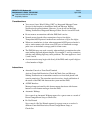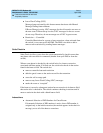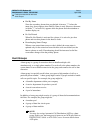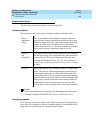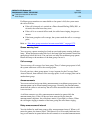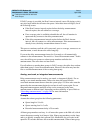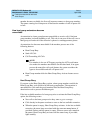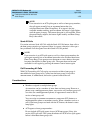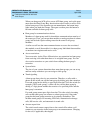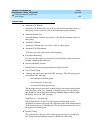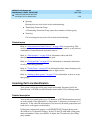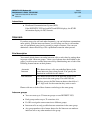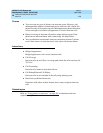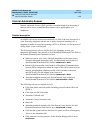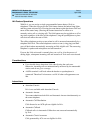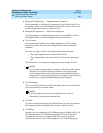
DEFINITY ECS Release 8.2
Administrator’s Guide
555-233-506
Issue 1
April 2000
Features and technical reference
1374Hunt Groups
20
When you change an ACD split to a non-ACD hunt group, each split agent
must enter the Hunt Group Busy deactivation code in order to receive calls
in that hunt group. If the agent has an
AUX-WORK button, the button lamp
lights when you make the change. The agent can then press the button to
become available for hunt-group calls.
■ Hunt group for communications devices
Members of a hunt group used for shared data communications must be of
the same type. Thus, you can put data modules or analog modems in a hunt
group, but not both. Option settings must be the same for all group
members.
A caller can still use the
DATA EXTENSION button to access the associated
data module, even if the module is in a hunt group. Individual data modules
or modems can originate and receive calls.
■ Access restrictions
You can restrict, via the Class of Restrictions, any extension in a hunt group
from receiving calls other than those to its assigned hunt group. You can
also restrict extensions on your switch from calling the hunt group’s
extension.
■ System limits
The size of your system determines how many hunt groups you can set up
and how many extensions you can assign to each group.
■ Trunk signaling
A hunt group always has its own extension. Therefore, a caller with a
phone on the switch can call the hunt group by dialing only that extension.
If a trunk group has the ability to pass digits from the CO to the switch (for
example, a DS1 trunk group), a caller can also call the hunt group by
dialing a 7-digit phone number that consists of a specified prefix and the
hunt group’s extension.
If a trunk group cannot pass digits from the CO to the switch, incoming
calls on that trunk group can connect to a hunt group only if the trunk
group has the hunt-group extension as its primary destination. This
includes trunk groups for incoming LDN calls, international exchange
calls, 800 service calls, and automatic tie-trunk calls.
■ Answer supervision
The switch sends answer supervision to the central office when a call
connects to an extension in the hunt group or an announcement. Charging
for the call, if applicable, then begins.



